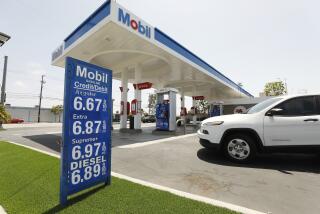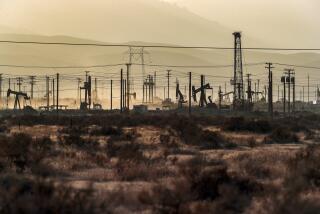Strategic Petroleum Reserve Quietly Fills as Cushion Against Oil Cutoff : Little-Noticed Supply in Underground Salt Domes Would Be Sold Early in Crisis to Prevent Hoarding by Consumers
- Share via
CHOCTAW BAYOU, La. — It looks like a gravel parking lot built in the middle of a swamp. Only a little complex of pipes in the corner hints at its purpose: to protect America from ever again falling victim to an oil embargo.
Underground is oil--millions and millions of barrels of oil here and elsewhere. Enough oil to equal 90 days’ worth of imports if there were a total cutoff of foreign oil, which accounts for more than a third of the oil America uses.
Ten years ago, in response to the 1973 Arab oil embargo, the United States started to protect itself from another oil shock by stockpiling petroleum for emergency use.
Congress in 1975 authorized a 1-billion-barrel cushion. Later it decided that was too ambitious, so it cut the Strategic Petroleum Reserve to 750 million barrels.
$15-Billion Cost
So far, more than 530 million barrels have been put away, at a cost of $15 billion, in the vast underground salt domes along the Texas and Louisiana coast. Some of the storage caverns extend a mile beneath the surface of the Earth.
If the word ever comes to flood the market with oil--to drown panic and fears of idle factories and gasoline lines resulting from a new embargo--the Strategic Petroleum Reserve would come into play, making its awesome existence felt wherever oil is used or pumped.
Someone like Alberta Thomas might be the person controlling the floodgates.
She would type commands into a computer console in an always-locked control room in a modest brick office building in St. James, 37 miles from Bayou Choctaw. That would open the valves to start the flow.
Thomas, an oil industry veteran, works for Boeing Petroleum Services, a subsidiary of the aerospace firm and operator of the Strategic Petroleum Reserve under contract with the Energy Department.
Government Terminal
She works at the government-owned St. James Terminal, connected to three major pipelines and its own two tanker berths on the Mississippi River in the sugar cane fields halfway between New Orleans and Baton Rouge.
The terminal, which can store 2 million barrels in six large white above-ground tanks, is also connected to Bayou Choctaw and another nearby underground salt dome where some of the oil is kept. Four other storage sites serve other pipelines and two private tanker terminals.
All told, the three terminals could dispatch 3 million barrels a day, roughly half the current rate of imports. If the reserve could displace imports entirely, it would last almost three months; at the maximum pumping rate, it would last almost six months.
The dispatch capacity is being raised gradually to 4.5 million barrels a day and the reserve is to reach the goal of holding 750 million barrels by the middle of the 1990s.
“I’m hoping we don’t have to do it,” Thomas said. But if the word should come down, “I think it’ll be a star for us.”
Importance Underscored
Operations manager Scott Landry said the importance of the reserve is underscored by recent events in the Persian Gulf--the U.S. decision to escort reflagged Kuwaiti tankers, and the threat of Iranian mines.
Many Americans are unaware of the existence of the reserve. Only three reporters have visited the site since May, 1986. Frank Lemoine, site manager at St. James, said neighbors “haven’t been paying any more attention.”
The senior Energy Department representative at the New Orleans headquarters, project manager John Wagoner, said he is not even getting much attention from Washington.
Though there has never been a security threat, the commercial guard service presents constant reminders. Briefcases must be opened. Visitors must be escorted. Guards do their best to look intimidating, with .357-caliber Magnums prominently strapped low on their thighs.
After the 1983 truck bombing of the U.S. Marine compound in Lebanon, all sites were provided with what the staff calls “Jersey bounces,” concrete dividers that force traffic to slow in a slalom pattern at the gate.
Safety Cited
The oil is safe, engineers believe--safe from terrorists, safe from natural disasters.
Except for some in a former salt mine, it is in gigantic cylindrical caverns that engineers have leached from the rock-hard salt formations by water injection, starting about 3,000 feet below the surface and extending to 5,000 feet.
Using technology familiar in the industry for decades, the engineers pump water into the dome and pump it out again as brine, leaving behind a cylindrical cavity big enough to hold 10 million barrels. There are several cavities to each site.
Choctaw Bayou site manager Ronald Chase says that, if a saboteur wrecked the pipes, the cavern would lose only 30,000 to 50,000 barrels of oil before cavern pressure would fall to zero and the flow would stop. Dikes around the gravel pad would catch the spill.
Fire could be a greater danger. The reserve buys only high-quality crude, and it will burn readily. New foam systems are being installed at the St. James tanks.
Oil Would Be Sold
As for matters of strategy concerning the Strategic Petroleum Reserve, the original idea--to save the oil as a last resort--has been abandoned. In 1982, the Reagan Administration decided that it would sell oil from the reserve early in a crisis to prevent a panicky rush by private consumers to hoard oil.
Analysts generally agree that the price explosion of 1979 that saw gasoline lines in parts of the country started with a panic. Buyers rushed to fill their tanks when Iranian shipments were cut off.
Only later did it become clear that consumption did not increase and that supplies did increase, as non-Iranian sources filled the gap.
Huge private inventories kept the market stable when the Iran-Iraq war broke out in 1980, removing almost 4 million barrels per day from world markets.
So far, it is hard to tell whether the reserve has exerted any effect on nervous oil markets, where prices for next-month delivery of crude rose in recent months but have eased recently.
‘Barely, Yes’
Ed Krapels, a Washington analyst whose assessments of world oil stocks are widely followed, was asked if the reserve had calmed the market. “I think the answer to that is, barely, yes,” he said.
But some oil experts disagree.
“I would say offhand that nobody, but nobody, has thought of the Strategic Petroleum Reserve in recent weeks,” said Ed McMahon, spokesman for Atlantic Refining Co. in Philadelphia.
Krapels’ consulting firm, Energy Security Analysis, recently published a hypothetical Persian Gulf scenario in which world production falls a net 3 million barrels per day, or about 6% of current world demand outside the communist bloc.
Under this scenario, consumers immediately fill tanks of gasoline, heating oil or other refined products; refineries increase output and draw down crude supplies, and cargoes at sea keep up crude deliveries to refineries for 45 to 60 days. Krapels concluded: “A SPRO drawdown of about 1.6 million barrels per day, if it can be implemented immediately, could keep crude markets in balance.” He underlined “immediately.”
Part of Energy Department
(Most officials use the acronym SPRO in referring to the Strategic Petroleum Reserve Office, part of the Energy Department.)
Only the United States, Japan and West Germany have significant government-owned “strategic” stockpiles. Japan has about 150 million barrels and Germany 53 million, though required company-owned stocks add to the German figure.
The United States could supply 3 million barrels per day and Japan another 1 million.
The idea behind the reserve was--and is--that no oil embargo lasts forever (the 1973 embargo was five months). Oil-producing countries eventually have to sell to somebody because they need the money.
More to Read
Sign up for Essential California
The most important California stories and recommendations in your inbox every morning.
You may occasionally receive promotional content from the Los Angeles Times.













